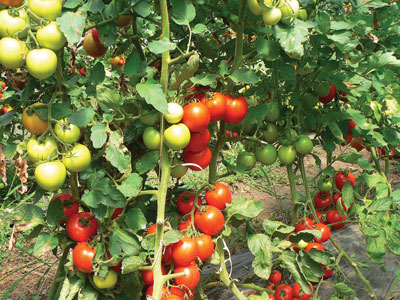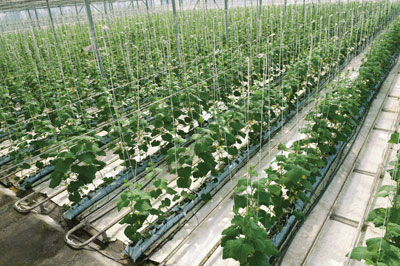
The incidences of micronutrient deficiencies in crops have increased
markedly in recent years due to intensive cropping and climate change.
This is the first in a two-part series on the role of micronutrients in greenhouse vegetable crop nutrition.
The incidences of micronutrient deficiencies in crops have increased markedly in recent years due to intensive cropping and climate change. The difference between a thriving crop and a struggling crop many times can be explained by the level of micronutrients in the plant.
 |
|
| Manganese deficiency can occur at the same time as iron deficiencies. PHOTOs COURTESY RACHEL CARSON, PLANT PRODUCTS
|
Micronutrients (boron, copper, iron, manganese, molybdenum and zinc) are co-factors in numerous physiological processes vital to crop production. Present only as a few parts per million (ppm) in plant tissues, these nutrients can have a huge impact on yield potential.
Unlike conventional soil culture, hydroponic culture of greenhouse vegetables is less forgiving and requires intense management. Although present automation systems can minimize fertilization and irrigation labour inputs, continuous monitoring of the system is important. Growers must be highly knowledgeable about plant growth, nutrient balances, cultural media characteristics, and plant physiology. This article will outline the important roles that micronutrients play in greenhouse vegetable production.
Boron (B) performs a wide variety of functions within the plant, such as translocation of sugars from the leaf to the fruit and incorporation into the cell wall structure of the plant. In addition, boron plays a part as a co-factor with other primary and secondary nutrients such as potassium and calcium.
Boron deficiencies are mainly found in acidic environments and can be easily leached from the rootzone. Boron deficiencies are more pronounced during periods when root activity is restricted. Greenhouse cucumbers are particularly susceptible to boron deficiencies.
Copper (Cu) is a component of numerous enzymes in the plant. These enzymes include defence enzymes, such as the antioxidant superoxide dismutase. Also, copper is a co-factor in enzymes, which enhance the flavours and colours of the fruit. In addition, copper is essential for sugar production during photosynthesis.
Copper uptake decreases with increases in media pH and increases in phosphorus and iron availability in media.
Iron (Fe) plays an important role in biochemical reactions during photosynthesis. Iron is involved as a co-factor in the reactions for the conversion of nitrate nitrogen to ammoniacal nitrogen. Iron is also involved in defence enzymes, such as the antioxidants catalase and peroxidase.
Uptake of iron decreases with increased media pH and is adversely affected by high levels of available phosphorus, manganese and zinc in the media.
Iron falls out of nutrient solutions quickly, compared to other micronutrients. Deficiencies are common in greenhouse tomatoes during fourth- and fifth-cluster development. Iron deficiency is also very common in greenhouse cucumbers.
Manganese (Mn) is involved in both carbohydrate production and plant self-defence.
Manganese plays an essential role in the production of lignin to prevent pathogen attacks.
Manganese is an important player in photosynthesis for sugar production, and is involved in the nitrogen cycle.
It is noted that toxicity of manganese can result in some acidic media and deficiencies can occur in media with high alkalinity.
In greenhouse tomato and cucumber production, manganese deficiency can occur at the same time as iron deficiencies. Close monitoring of the nutrient solution and plant tissue nutrient levels will help distinguish between the two deficiencies.
Molybdenum (Mo) is involved in the nitrogen cycle, a co-factor in the important enzyme of nitrate reductase. Molybdenum deficiencies can occur in acidic media during periods of high humidity. Plant uptake of molybdenum increases with increases in media pH, which is opposite to the majority of other micronutrients.
Zinc (Zn) is a co-factor in numerous enzymes related to plant self-defence, such as antioxidant production. In addition, zinc is required for the synthesis of the growth hormone auxin (indolacetic acid).
 |
|
| The true benefit of any fertilizer is determined by the amount of nutrient that is actually taken up by the crop.
|
Uptake of zinc decreases with increases of media pH and is adversely affected by high levels of available phosphorus and iron in the media.
Micronutrients work with enzymes, macronutrients (nitrogen, phosphorus, and potassium) and secondary nutrients (calcium and magnesium) throughout the life cycle of the crop.
- During the seedling stage, zinc is required in greater amounts for producing auxin for new growth.
- Nitrogen, copper, iron and manganese work together during photosynthesis to produce sugars.
- Molybdenum and nitrogen work tougher during the nitrogen cycle.
- Boron and potassium work together to traffic sugars and metabolites from the leaves to the fruit during fruit development.
- Boron and calcium work together to bind pectin fibres together to form fruit skin.
These are some of the many examples of how micronutrients are involved in numerous physiological processes. Micronutrients are as important as nitrogen, phosphorus, potassium, calcium and magnesium in plant nutrition; however, the amounts of micronutrients required for optimum crop yields are much lower.
Water and plant tissue analyses are excellent diagnostic tools to monitor the micronutrient status of the media and crop. Visual deficiency symptoms of these nutrients are also well recognized in most crops. Micronutrient recommendations are based on water and plant tissue analyses, the crop species, expected yield, management level, and research results.
The true benefit of any fertilizer is only in the amount of nutrient that is actually taken up by the crop. Yield gains come from the nutrients being in the correct chemical form, place, time and amount that the crop requires.

|
Rachel Carson, M.Sc., P.Ag., is product development manager with Plant Products Co. Ltd.
• www.plantprod.com
Print this page